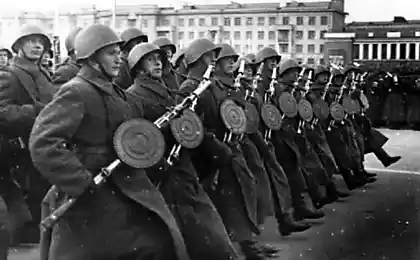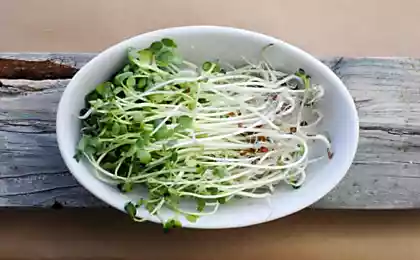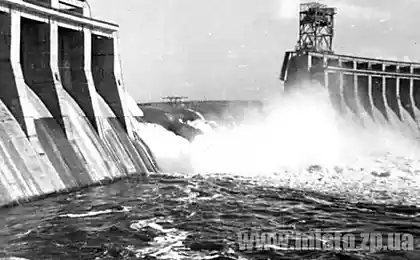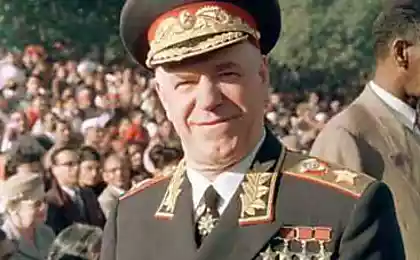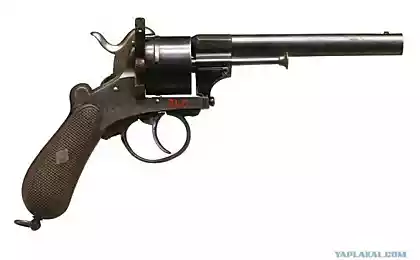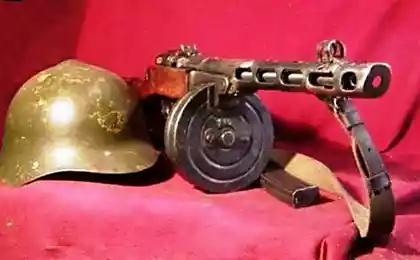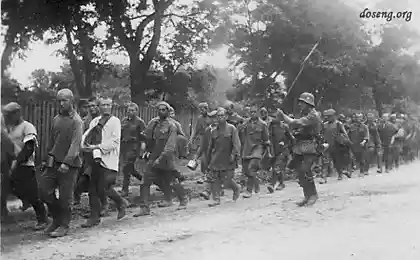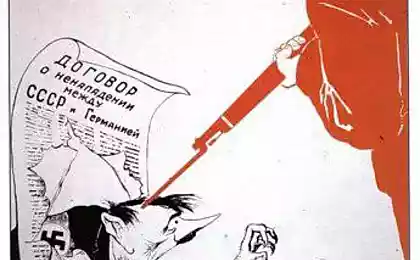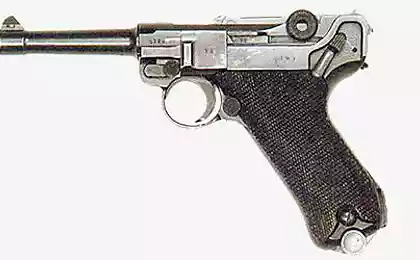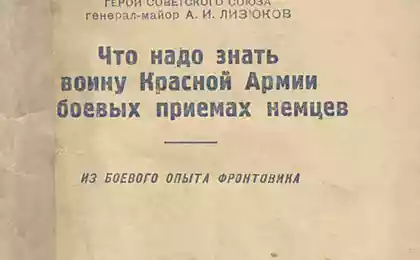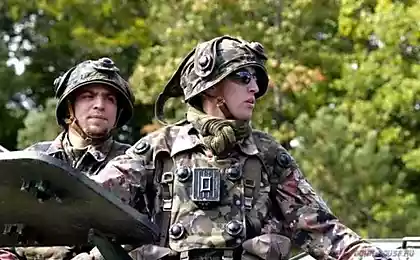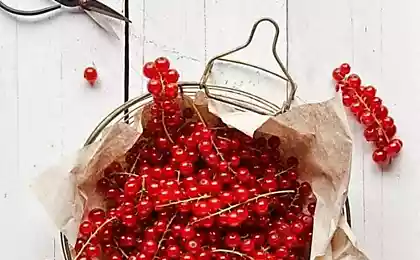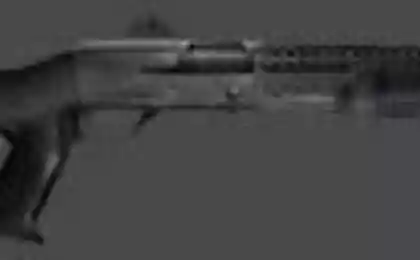743
Where the Red Army took "narkomovskie 100 g
will be 3 Picchu and text
source
FROM CIVIL TO FINNISH
Stalin and Voroshilov were people drinking. Nikita Khrushchev recalled the case of the Civil War: "When Stalin was in Tsaritsyn, he went on grain procurement and at the same time taking measures to organize the defense of Tsaritsyn. There, along with the 5th Army retreated from Ukraine Voroshilov, and there they met with Stalin.
Stalin said that Lenin had summoned him to Moscow to report on the state of affairs. Then Lenin said to him: "My friend, I got information that you are there pyanstvuete: they drink and other solder. You can not do it! »
In general, and "leader of the peoples" and "First Marshal" effect of alcohol "in combat" knew well.
In any case, in January 1940, during the Finnish campaign Commissar Voroshilov turned to Stalin with a request: Due to severe weather conditions and frost was in his late thirties, to give men and commanders of a hundred grams of vodka and 50 grams of fat a day. Secretary General immediately agreed. Tankers rate doubled, and the pilots as the elite of the Armed Forces decided to give 100 grams of cognac. From the 10th of January and the beginning of March 1940 the soldiers of the Red Army had been drunk more than 10 tons of vodka and 8, 8 tons of cognac. But the troops were two new concepts: "Voroshilov rations" (vodka and bacon) and "narkomovskie 100 grams» ...
01.
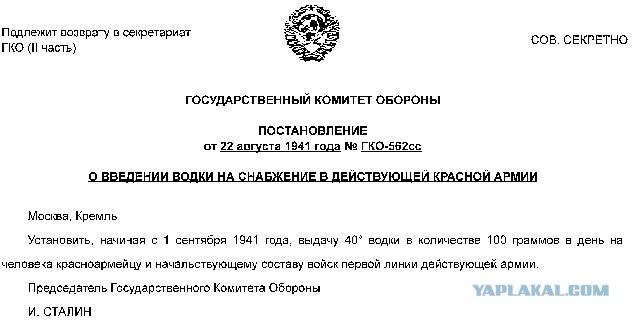
HOT SUMMER forty-first
In the summer of 1941, the vodka in the army began to issue in July. Although the order of the People's Commissar of Defence number 0320 was signed not by the People's Commissar, and his deputy, Lieutenant-General Quartermaster Corps Khruleva and only appeared August 25, 1941. But in this case there was only Khrulev performer. Three days before the order was issued GKO Stalin signed a decree under the heading "owls. Secret "to read (see above Picchu)
The specifies the resolution order titled "On the issue of military front lines of the army of vodka 100 grams a day," noted that the pilots performing combat missions, and engineering staff airfields of the army should receive vodka on a par with the soldiers who fought on the front lines. < br />
Vodka delivers on many fronts in railway tanks (approximately 43 - 46 tanks per month). It was then poured into barrels or milk cans and sent to the units. Where had the opportunity, alcohol could issue in a glass container.
By the way, in the order of T-bills and pointed out by strength of vodka - 40 degrees ... With vodka went on the attack, as it commemorated their fallen comrades. A warm up in the summer was not necessary - it took the fall, winter and early spring of next 1942 years ... Sportsman's Day? Pours!
The drop morale of troops after the defeat at Kharkov and Crimea forced Stalin once again raise the question of vodka at the forefront. In May 1942, he decided that the issue of "narkomovskih 100 grams" must be differentiated. Nevertheless, the signing of the GKO was postponed for June. Stalin himself has made serious editorial changes to the document.
The project involved "to save the issuance of vodka only military personnel are often the front line, having success in the fight against the Nazi invaders, increasing it to 200 grams a day," but Stalin made his red pencil corrections.
The text is now saved "narkomovskie" only for those parts of the front line, soldiers whose conduct offensive operations. The other parts of the military frontline 100 grams were now put only on holidays.
These included revolutionary and public solemn day: the anniversary of the October Revolution of November 7 and 8, the Day of the Constitution of December 5, the Red Army Day on February 23 All-Union Day of Aviation on August 16 Feast of the regiment (the formation of the part) and somehow Union Day sporty 19 of July. International Youth Day on September 6 was present in the project, "the best friend of children" strongly struck ...
02.
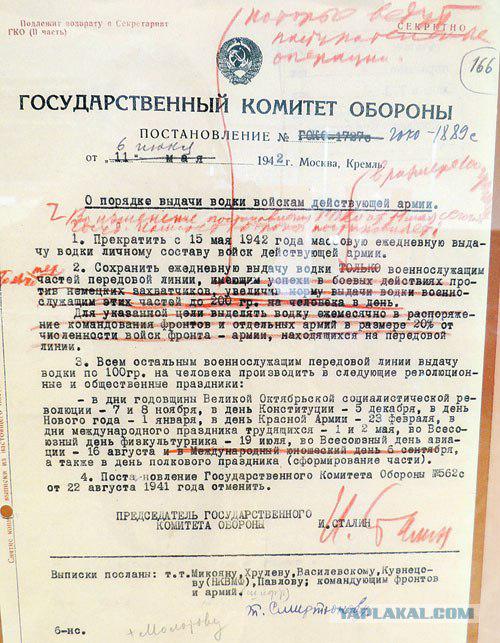
"Weapon of victory»
November 12, 1942, a week before the transition to the offensive of the Soviet troops at Stalingrad, the newly streamlined the issuance of T-bills of alcohol-Skaha howling. And regulations, and orders became more liberal: 100 grams poured everyone who was at the front and led the fighting.
There were also artillery - mortar, fire supported the infantry. Tylovikov - regimental and divisional reserves, construction battalion, who "worked under enemy fire," and injured (by doctor's permission) is now poured on 50 grams per day.
But the Transcaucasian Front were allowed instead of vodka to give 200 grams of port or 300 grams of dry wine a day. Over the last month the Western Front in 1942 drank almost a million liters of vodka, Stalingrad - 407 000 liters, and the Transcaucasian - 1, 2 million liters of wine ...
Later rations of alcohol in the army was revised again. April 30th, 1943, Stalin signed GKO Resolution number 3272 "On the order of issuance of vodka troops of the army." The summons NGO stated: "1. Stop with the May 3, 1943 issue of vodka daily mass of troops of the army. 2. Issuance of vodka 100 grams per day per person to produce military only those parts of the front line that are offensive, and determine exactly how armies and connections issue vodka rests with the military councils of the fronts and separate armies. 3. All the other soldiers of the army of vodka in the issuance of 100 grams per person per day produced in the revolutionary days and public holidays ».
Immediately after the Battle of Kursk in the list of Limit consumption of vodka for the first time were part of the NKVD and the railway troops that would be required from November 25 to December 31, 1943 vodka as much as the whole of the North-Caucasian Front.
Cancellation of the same issue was vodka in parts of the army in connection with the surrender of Nazi Germany in May 1945 ...
and after the war:
In the Soviet army personnel alcohol was not supposed to. Also 100 grams of dry wine a day sailors on nuclear submarines during the military campaign.
It is said that many of the rations consumed by turns with his friends - to double or even triple the dose. The ground forces came to the aid of the suffering self-made "miracles of technology" in the form of various stills very intricate configuration.
03.Snimok military photojournalist Nikolai Khandogin: 1942, "narkomovskie 100 grams" for the senior sergeant of the Red Army.
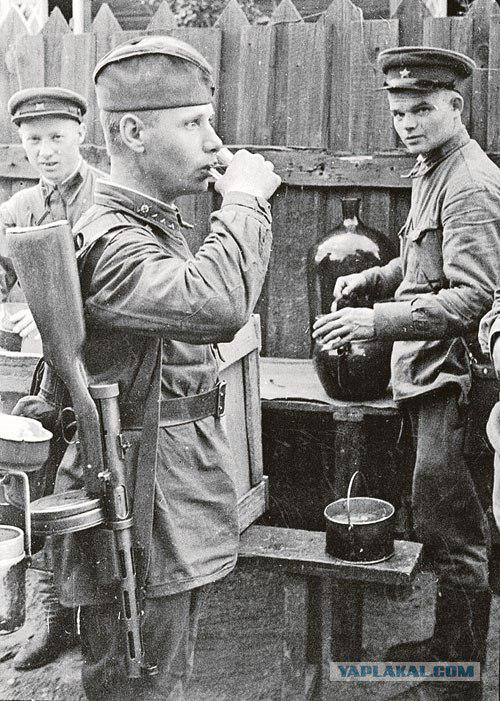
Source:
source
FROM CIVIL TO FINNISH
Stalin and Voroshilov were people drinking. Nikita Khrushchev recalled the case of the Civil War: "When Stalin was in Tsaritsyn, he went on grain procurement and at the same time taking measures to organize the defense of Tsaritsyn. There, along with the 5th Army retreated from Ukraine Voroshilov, and there they met with Stalin.
Stalin said that Lenin had summoned him to Moscow to report on the state of affairs. Then Lenin said to him: "My friend, I got information that you are there pyanstvuete: they drink and other solder. You can not do it! »
In general, and "leader of the peoples" and "First Marshal" effect of alcohol "in combat" knew well.
In any case, in January 1940, during the Finnish campaign Commissar Voroshilov turned to Stalin with a request: Due to severe weather conditions and frost was in his late thirties, to give men and commanders of a hundred grams of vodka and 50 grams of fat a day. Secretary General immediately agreed. Tankers rate doubled, and the pilots as the elite of the Armed Forces decided to give 100 grams of cognac. From the 10th of January and the beginning of March 1940 the soldiers of the Red Army had been drunk more than 10 tons of vodka and 8, 8 tons of cognac. But the troops were two new concepts: "Voroshilov rations" (vodka and bacon) and "narkomovskie 100 grams» ...
01.

HOT SUMMER forty-first
In the summer of 1941, the vodka in the army began to issue in July. Although the order of the People's Commissar of Defence number 0320 was signed not by the People's Commissar, and his deputy, Lieutenant-General Quartermaster Corps Khruleva and only appeared August 25, 1941. But in this case there was only Khrulev performer. Three days before the order was issued GKO Stalin signed a decree under the heading "owls. Secret "to read (see above Picchu)
The specifies the resolution order titled "On the issue of military front lines of the army of vodka 100 grams a day," noted that the pilots performing combat missions, and engineering staff airfields of the army should receive vodka on a par with the soldiers who fought on the front lines. < br />
Vodka delivers on many fronts in railway tanks (approximately 43 - 46 tanks per month). It was then poured into barrels or milk cans and sent to the units. Where had the opportunity, alcohol could issue in a glass container.
By the way, in the order of T-bills and pointed out by strength of vodka - 40 degrees ... With vodka went on the attack, as it commemorated their fallen comrades. A warm up in the summer was not necessary - it took the fall, winter and early spring of next 1942 years ... Sportsman's Day? Pours!
The drop morale of troops after the defeat at Kharkov and Crimea forced Stalin once again raise the question of vodka at the forefront. In May 1942, he decided that the issue of "narkomovskih 100 grams" must be differentiated. Nevertheless, the signing of the GKO was postponed for June. Stalin himself has made serious editorial changes to the document.
The project involved "to save the issuance of vodka only military personnel are often the front line, having success in the fight against the Nazi invaders, increasing it to 200 grams a day," but Stalin made his red pencil corrections.
The text is now saved "narkomovskie" only for those parts of the front line, soldiers whose conduct offensive operations. The other parts of the military frontline 100 grams were now put only on holidays.
These included revolutionary and public solemn day: the anniversary of the October Revolution of November 7 and 8, the Day of the Constitution of December 5, the Red Army Day on February 23 All-Union Day of Aviation on August 16 Feast of the regiment (the formation of the part) and somehow Union Day sporty 19 of July. International Youth Day on September 6 was present in the project, "the best friend of children" strongly struck ...
02.

"Weapon of victory»
November 12, 1942, a week before the transition to the offensive of the Soviet troops at Stalingrad, the newly streamlined the issuance of T-bills of alcohol-Skaha howling. And regulations, and orders became more liberal: 100 grams poured everyone who was at the front and led the fighting.
There were also artillery - mortar, fire supported the infantry. Tylovikov - regimental and divisional reserves, construction battalion, who "worked under enemy fire," and injured (by doctor's permission) is now poured on 50 grams per day.
But the Transcaucasian Front were allowed instead of vodka to give 200 grams of port or 300 grams of dry wine a day. Over the last month the Western Front in 1942 drank almost a million liters of vodka, Stalingrad - 407 000 liters, and the Transcaucasian - 1, 2 million liters of wine ...
Later rations of alcohol in the army was revised again. April 30th, 1943, Stalin signed GKO Resolution number 3272 "On the order of issuance of vodka troops of the army." The summons NGO stated: "1. Stop with the May 3, 1943 issue of vodka daily mass of troops of the army. 2. Issuance of vodka 100 grams per day per person to produce military only those parts of the front line that are offensive, and determine exactly how armies and connections issue vodka rests with the military councils of the fronts and separate armies. 3. All the other soldiers of the army of vodka in the issuance of 100 grams per person per day produced in the revolutionary days and public holidays ».
Immediately after the Battle of Kursk in the list of Limit consumption of vodka for the first time were part of the NKVD and the railway troops that would be required from November 25 to December 31, 1943 vodka as much as the whole of the North-Caucasian Front.
Cancellation of the same issue was vodka in parts of the army in connection with the surrender of Nazi Germany in May 1945 ...
and after the war:
In the Soviet army personnel alcohol was not supposed to. Also 100 grams of dry wine a day sailors on nuclear submarines during the military campaign.
It is said that many of the rations consumed by turns with his friends - to double or even triple the dose. The ground forces came to the aid of the suffering self-made "miracles of technology" in the form of various stills very intricate configuration.
03.Snimok military photojournalist Nikolai Khandogin: 1942, "narkomovskie 100 grams" for the senior sergeant of the Red Army.

Source:
